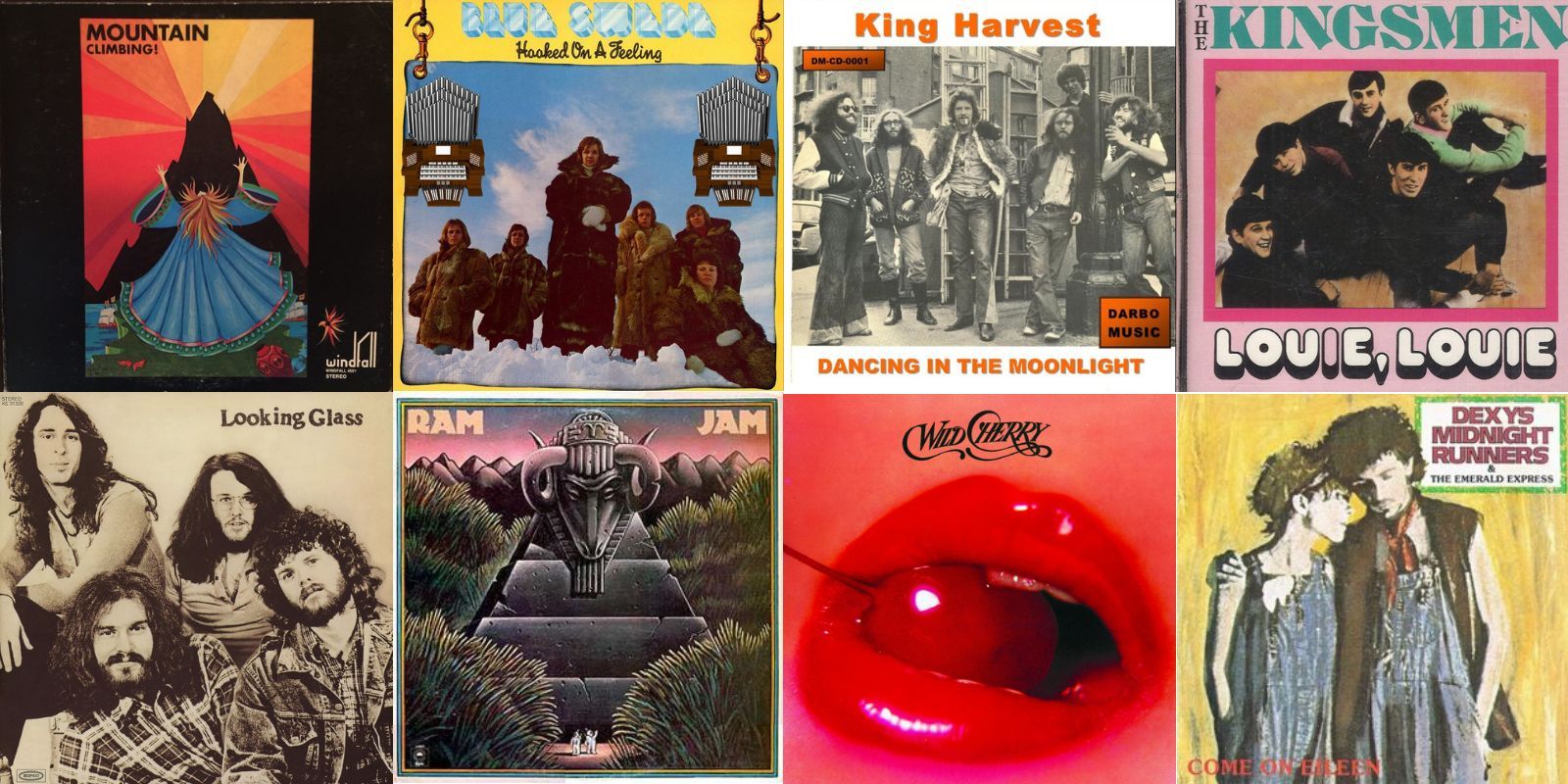Some one-hit wonders in music make sense. A band unexpectedly gets everything just right exactly one time, but never comes close to capturing that magic again. Other one-hit wonders are more confusing. A creative, talented act puts out inventive, catchy music for years, but outside factors work against them, and they never manage to find their way back onto the charts.
In either case, these acts often have interesting stories behind them, from surprising twists to tragic endings. Sometimes a one-hit wonder never panned out, but it served as a training ground for its members. These 10 artists only ever had one single reach the Top 40 in the US, yet they warrant both a deeper listen and better understanding.
10
The Jaggerz
“The Rapper” (1970)
Pittsburgh’s The Jaggerz (could there be a more western Pennsylvanian name?) might have the distinction of being the only band whose career improved when they quit working with Gamble and Huff. Their debut album went nowhere.
They moved to a new label and shifted from blue-eyed soul to (mostly) radio-friendly pop. The group’s “The Rapper” took off, reaching #2 in the charts (while “Bridge Over Troubled Water” was at its peak) and eventually going gold.

Related
10 Huge Bands Who Unbelievably Never Had A Number 1
By no stretch does chart success always align with true musical greatness, and it’s certainly not where such greatness is usually born.
The band put out one more album before parting ways. They reunited in 1989 for live shows, eventually releasing some of their strongest albums (mainly by revisiting the past).
Frontman Donnie Iris went on to a career oddity by joining Wild Cherry, who became their own one-hit wonder with “Play That Funky Music.” Iris has had a steady solo career, mainly finding regional success in the Pittsburgh/Cleveland area.
9
The Ides Of March
“Vehicle” (1970)
Sometimes it just takes a trumpet. The Ides Of March had found mild success with “You Wouldn’t Listen,” but then they added a trumpet player. Which led to another one, and a saxophone – and suddenly they had something special.
They released “Vehicle” in 1970, and it sped to #2 in the charts, giving them major success. The full album Vehicle didn’t fare as well, though its combination of rock, jazz, and even folk deserves more attention.
The core of The Ides Of March eventually got together and have celebrated over 50 years together.
The group held on for a few more albums but eventually ditched the horns and disintegrated. Vocalist/guitarist/songwriter Jim Peterik was done, though. He moved on to found Survivor, which found success in the ’80s, most notably with “Eye of the Tiger.” He’s also had a long songwriting career.
The core of The Ides Of March eventually got together and have celebrated over 50 years together (Survivor-era aside).
8
Mountain
“Mississippi Queen” (1970)
It can get a little confusing. Guitarist Leslie West released an album called Mountain. Then he formed a band called Mountain. Mountain then released Climbing!, an excellent example of the era.
The single “Mississippi Queen” tore up the charts. Its cowbell, heavy guitar riff, and hard vocal making for a nearly perfect track. “For Yasgur’s Farm” followed, but failed to capture the audience it deserved.

Related
10 Best Classic Rock One-Hit Wonders (& What Happened To Them)
These classic rock hits are inescapable, but the bands who made them have slipped under the radar. This is where they went after the success.
Mountain should have had a more prominent career, with music that suited the time without feeling redundant. The band could go spacey or bluesy at any moment, always with strong hooks. Nantucket Sleighride sold well, but failed to make its mark.
After the band split up, West had a solid solo career before reuniting the group, which carried on sporadically. West passed away in 2020, his legacy perhaps more notable among guitarists than casual fans, but his work deserves attention for more than just that one hit.
7
Pacific Gas & Electric
“Are You Ready?” (1970)
Maybe Pacific Gas & Electric suffered from their band’s name. They certainly didn’t suffer from their musical quality, a mix of blues, psych, and hard rock perfect for the late ’60s. When they finally got their break, it was in an unexpected way.
“Are You Ready?” rocks, but sounds like the shoutings of a street preacher about the Second Coming, an unlikely character for a run up the charts in 1970 – but it worked for the band.
Without another hit, they broke up (even changing their name to PG&E couldn’t save them), but member Glenn Schwartz followed the lead of this song, founding the All Saved Freak Band. The group became part of the burgeoning hippie-led Jesus music scene.
Several of his former bandmates left the music industry, but drummer Alvin Taylor and guitarist Paul Warren carried on in various ways.
6
Free
“All Right Now” (1970)
Free might be best remembered as the forerunner of another band, but they had a brief flash in 1970. Single “All Right Now” reached number four in the US, leading its album Fire and Water to unexpected success.
The record has its moments, but nothing on it comes close to its anthemic hit. The band would stumble on for a few more years, but never really find their way.
Despite being a one-hit wonder, Free turned out to be a remarkable launching pad.
After the split, though, things got much more interesting. Singer Paul Rodgers and drummer Simon Kirke went on to found Bad Company (along with Mott The Hoople’s Mick Ralphs), which would immediately produce a string of Top 40 hits, largely by boosting the foundation laid with Free.
Rodgers would also join Queen for a run in the ’00s. Despite being a one-hit wonder, Free turned out to be a remarkable launching pad.
5
Richie Havens
“Here Comes The Sun” (1971)
The oddest aspect of Richie Havens’ career is that he only had one hit, which he didn’t write and isn’t the best-known version of the song. In 1971, Richie Havens released his take on The Beatles’ “Here Comes The Sun,” and it became a smash hit. The easygoing folk rock number helped Alarm Clock become Haven’s most successful album.

Related
14 Songs You Completely Forgot Are Covers Of Other Songs
Many beloved hits are actually covers of songs written and popularized by another artist. Here are 14 that have superseded the originals.
Havens himself had a career far bigger than just a single hit. His performance at Woodstock remains one of the most memorable of the festival, highlighted by his performances of his “Freedom” and the traditional “Motherless Child.”
Havens continued to perform throughout his life, using his folk music to speak out on a variety of issues. Despite his remarkable career, he never again had a Top 40 hit.
4
Uriah Heep
“Easy Livin'” (1972)
Uriah Heep had a significant career, establishing proto-metal and prog rock, peaking in the early ’70s. Oddly, given their skill and energy, the band only recorded one Top 40 song, “Easy Livin'” from 1972’s Demons and Wizards. Even that one barely squeaked in, reaching just #39 despite its intense guitar, driving bass, and distinctive organ.

Related
10 Best Metal One-Hit Wonders (& What Happened To Them)
Despite the metal genre having one of the most loyal fanbases in music, these one-hit wonders only temporarily caught people’s attention.
The band was unfazed, and while they unfortunately dropped from mainstream consideration, they hardly slowed down. Despite lineup changes, the group continues to this day (Mick Box is the only remaining founding member), having released 25 studio albums, including the well-received Chaos & Colour just two years ago.
It’s just one more reason that fans of Led Zeppelin and Deep Purple should make sure not to overlook Uriah Heep.
3
Mott The Hoople
“All The Young Dudes” (1972)
After four albums and limited success (at best), Mott The Hoople were ready to call it quits. Enter David Bowie. The rocker first offered them “Suffragette City,” which they turned down, and then he sang “All The Young Dudes” for them.
The members of Mott The Hoople immediately recognized its greatness, and recorded their version. It became not only a commercial hit, but also one of the most important glam rock songs of the era.
The band wouldn’t last much longer, although variations of it limped on after lead vocalist Ian Hunter’s departure. Ralphs, as noted above, co-founded Bad Company.
Hunter continues releasing music. His solo career has been relatively successful, including “Once Bitten, Twice Shy” and “England Rocks,” two songs better known today for their cover versions. Mott The Hoople might have only had one true hit, but it’s hard to imagine glam rock without their presence.
2
Thin Lizzy
“The Boys Are Back In Town” (1976)
Thin Lizzy provides another example of a band that should have had more than one hit. “The Boys Are Back In Town” is an obvious classic, with its dual lead guitars and cool vocals defining a certain style of hard rock.
The song was a massive boost to Thin Lizzy’s career, and has been in steady radio rotation for 50 years, but they put out a number of singles, including “Whiskey In The Jar” and “Jailbreak” that should have ripped up the charts.
At the time, “The Boys Are Back In Town” wasn’t an obvious classic. The band nearly didn’t even include it in on Jailbreak, but doing so likely saved their career.
After their commercial peak, Thin Lizzy put out a string of strong albums and found much more success in the UK and their native Ireland than in the US. Newcomers should in particular investigate Black Rose: A Rock Legend from 1979.
Constant lineup changes, personal issues, and drug problems eventually did in the band. Guitarist Gary Moore had a career of note, but vocalist/songwriter/bassist Phil Lynott died at just 36.
1
William Bell
“Tryin’ To Love Two” (1977)
William Bell could have been a massive mainstream star. He signed to Stax early, but the start of his career was complicated when he was drafted into the army. He shone as a songwriter, and his “Born Under A Bad Sign” (co-written with Booker T.) became a hugely influential blues release.
After half a century in the business, he returned to Stax and put out the finest album of his career.
When he finally cracked the top 10 as a solo artist, it wasn’t even with his best song (that would be “I Forgot To Be Your Lover”). But at least he finally got there, and “Tryin’ To Love Two” deserves its chart success.
He continued to have an interesting career, founding two labels before taking a break from recording. After half a century in the business, he returned to Stax and put out the finest album of his career, 2016’s This Is Where I Live, which appropriately won the Grammy Award for Best Americana Album.


